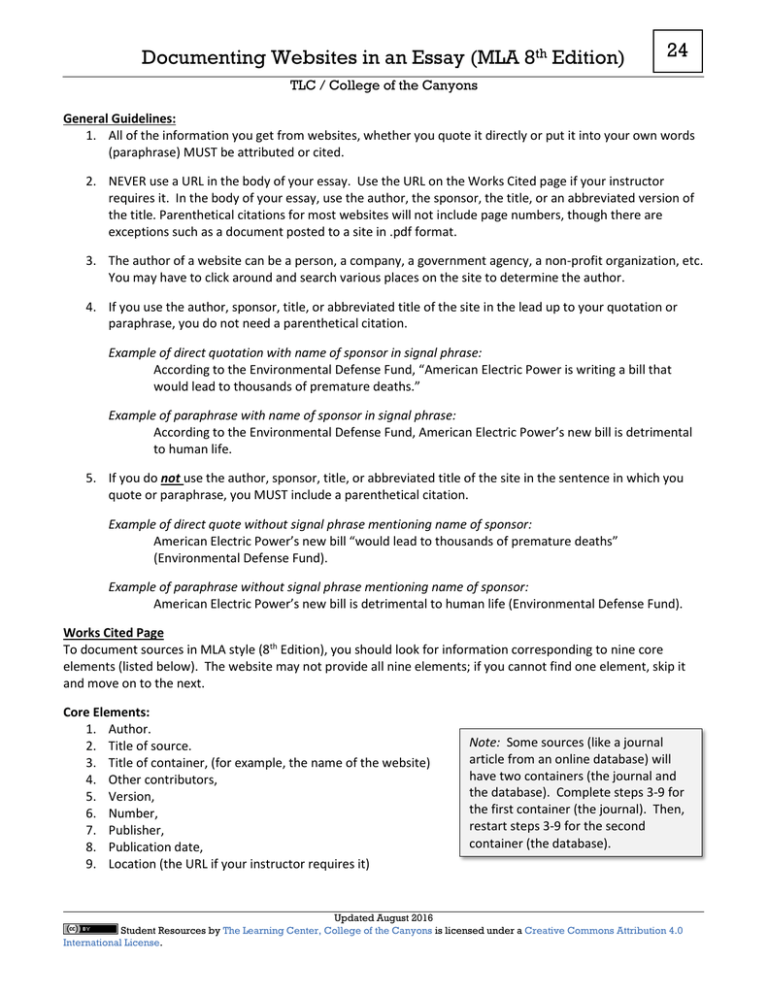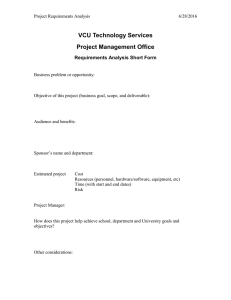Documenting Websites in an Essay
advertisement

Documenting Websites in an Essay (MLA 8th Edition) 24 TLC / College of the Canyons General Guidelines: 1. All of the information you get from websites, whether you quote it directly or put it into your own words (paraphrase) MUST be attributed or cited. 2. NEVER use a URL in the body of your essay. Use the URL on the Works Cited page if your instructor requires it. In the body of your essay, use the author, the sponsor, the title, or an abbreviated version of the title. Parenthetical citations for most websites will not include page numbers, though there are exceptions such as a document posted to a site in .pdf format. 3. The author of a website can be a person, a company, a government agency, a non-profit organization, etc. You may have to click around and search various places on the site to determine the author. 4. If you use the author, sponsor, title, or abbreviated title of the site in the lead up to your quotation or paraphrase, you do not need a parenthetical citation. Example of direct quotation with name of sponsor in signal phrase: According to the Environmental Defense Fund, “American Electric Power is writing a bill that would lead to thousands of premature deaths.” Example of paraphrase with name of sponsor in signal phrase: According to the Environmental Defense Fund, American Electric Power’s new bill is detrimental to human life. 5. If you do not use the author, sponsor, title, or abbreviated title of the site in the sentence in which you quote or paraphrase, you MUST include a parenthetical citation. Example of direct quote without signal phrase mentioning name of sponsor: American Electric Power’s new bill “would lead to thousands of premature deaths” (Environmental Defense Fund). Example of paraphrase without signal phrase mentioning name of sponsor: American Electric Power’s new bill is detrimental to human life (Environmental Defense Fund). Works Cited Page To document sources in MLA style (8th Edition), you should look for information corresponding to nine core elements (listed below). The website may not provide all nine elements; if you cannot find one element, skip it and move on to the next. Core Elements: 1. Author. 2. Title of source. 3. Title of container, (for example, the name of the website) 4. Other contributors, 5. Version, 6. Number, 7. Publisher, 8. Publication date, 9. Location (the URL if your instructor requires it) Note: Some sources (like a journal article from an online database) will have two containers (the journal and the database). Complete steps 3-9 for the first container (the journal). Then, restart steps 3-9 for the second container (the database). Updated August 2016 Student Resources by The Learning Center, College of the Canyons is licensed under a Creative Commons Attribution 4.0 International License. Documenting Websites in an Essay (MLA 8th Edition) 24 TLC / College of the Canyons Turning the Elements into a Citation: 1. Author: Emily Deruy 2. Title: “Does Mindfulness Actually Work in Schools?” 3. Title of Container: The Atlantic 4. Other contributors: none 5. Version: none 6. Number: none 7. Publisher: The Atlantic Monthly Group 8. Publication Date: 20 May 2016 9. Location: http://www.theatlantic.com/education/archive/2016/05/t esting-mindfulness-in-the-early-years/483749/ Deruy, Emily. “Does Mindfulness Actually Work in Schools?” The Atlantic, The Atlantic Monthly Group, 20 May 2016, http://www.theatlantic.com/educati on/archive/2016/05/testingmindfulness-in-the-earlyyears/483749/. Sample Citations: Web Article with an author: Deruy, Emily. “Does Mindfulness Actually Work in Schools?” The Atlantic, The Atlantic Monthly Group, 20 May 2016, http://www.theatlantic.com/education/archive/2016/05/testing-mindfulness-in-the-earlyyears/483749/. Website with an Organization as Author: American Library Association. “About Banned and Challenged Books.” American Library Association, American Library Association, 2016, http://www.ala.org/bbooks/about. YouTube Clip or Other Short Online Video: Desmond-Hellmann, Sue. “A Smarter, More Precise Way to Think about Public Health.” TED, TED Conferences, February 2016, http://www.ted.com/talks/sue_desmond_hellmann_a_smarter_more_precise_way_to_think_about_pub lic_health. Blog: Fogarty, Mignon. “Why Is It Called Commencement?” Grammar Girl, Macmillan Holdings, 19 May 2016, http://www.quickanddirtytips.com/education/grammar/why-is-it-called-commencement. Tweet: @NASA. “Iridescent blues of Australia’s Great Barrier Reef as Seen from Space Station.” Twitter, 31 May 2016, 12:15 p.m., https://twitter.com/NASA. Journal Article from an Online Database: Cimino, Megan, et al. “Satellite Data Identify Decadal Trends in the Quality of Pygoscelis Penguin Chick-Rearing Habitat.” Global Change Biology, vol. 19, no. 1, Jan. 2013, pp. 136-148. Academic Search Premier, doi: 10.1111/gcb.12016. Online tutorial available here. Updated August 2016 Student Resources by The Learning Center, College of the Canyons is licensed under a Creative Commons Attribution 4.0 International License.

